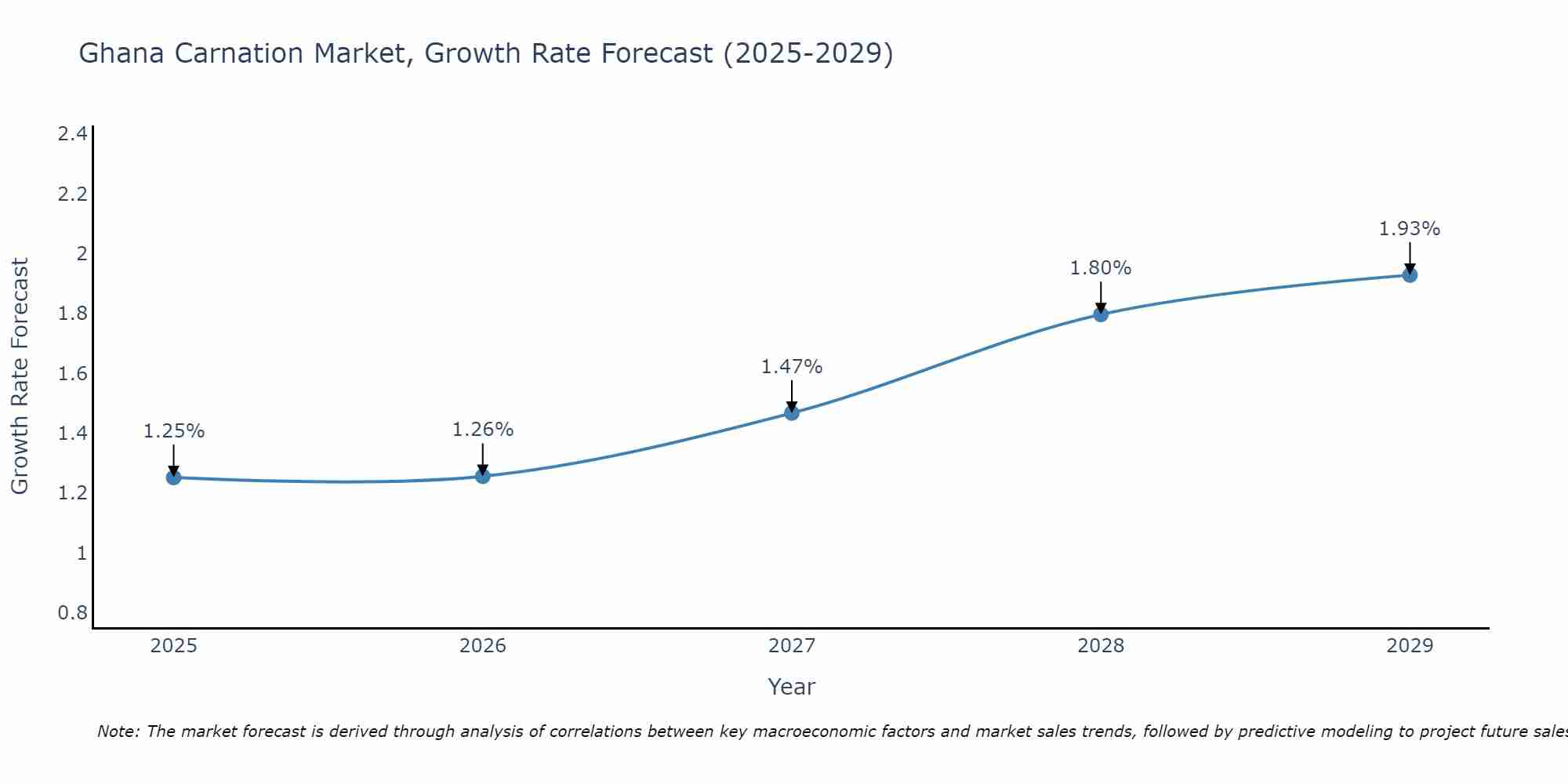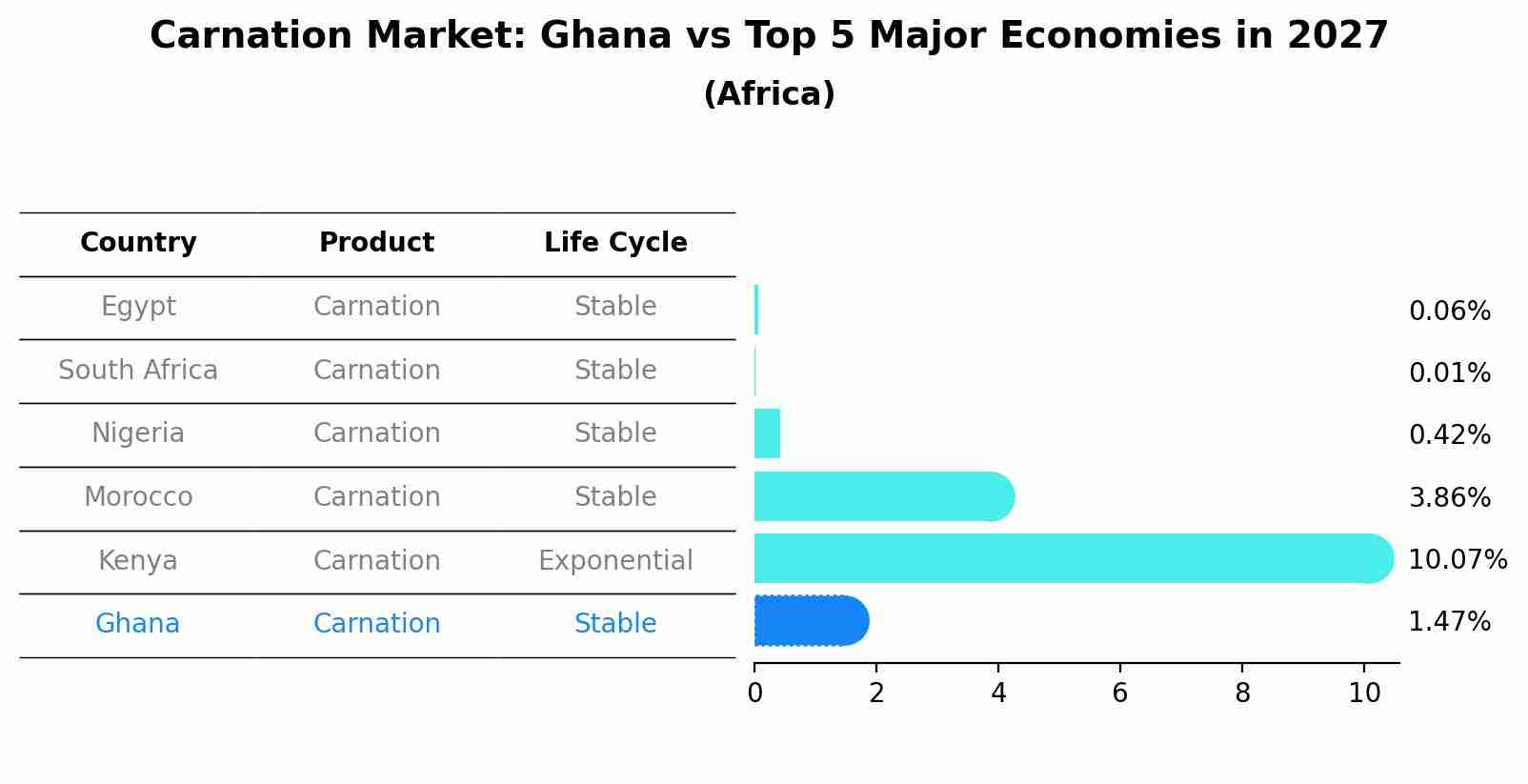Ghana Carnation Market (2025-2031) Outlook | Growth, Analysis, Forecast, Revenue, Value, Industry, Trends, Companies, Size & Share
| Product Code: ETC409012 | Publication Date: Oct 2022 | Updated Date: Apr 2025 | Product Type: Market Research Report | |
| Publisher: 6Wresearch | Author: Shubham Padhi | No. of Pages: 75 | No. of Figures: 35 | No. of Tables: 20 |
Ghana Carnation Market Size Growth Rate
The Ghana Carnation Market is poised for steady growth rate improvements from 2025 to 2029. Commencing at 1.25% in 2025, growth builds up to 1.93% by 2029.

Carnation Market: Ghana vs Top 5 Major Economies in 2027 (Africa)
The Carnation market in Ghana is projected to grow at a stable growth rate of 1.47% by 2027, highlighting the country's increasing focus on advanced technologies within the Africa region, where Egypt holds the dominant position, followed closely by South Africa, Nigeria, Morocco and Kenya, shaping overall regional demand.

Ghana Carnation Market Overview
The Ghana Carnation Market is experiencing growth driven by factors such as floriculture industry development, floral gifting traditions, and decorative purposes. Carnations, popular flowers known for their colorful blooms and long-lasting freshness, are cultivated and traded in Ghana for various occasions such as weddings, celebrations, and decorative arrangements, contributing to their demand and market expansion.
Drivers of the market
The Ghana carnation market is driven by the flower`s popularity in various occasions such as weddings, festivals, and funerals. Changing consumer preferences towards floral decorations and gifting culture are also influencing market dynamics.
Challenges of the market
Challenges in the carnation market in Ghana include limited access to quality seeds and technical expertise for cultivation, as well as vulnerability to weather fluctuations and pests. Moreover, competition from imported flowers and seasonal demand variations pose market competitiveness challenges.
Government Policy of the market
Government interventions in the carnation market may aim to support flower cultivation, floriculture industry development, and export promotion. Policies might include incentives for carnation growers, such as subsidies, tax breaks, and access to credit, to expand production and improve product quality. Additionally, the government may facilitate market access for carnation exporters through trade agreements, market intelligence, and export promotion initiatives. Capacity-building programs for flower farmers, exporters, and industry associations on cultivation techniques, post-harvest handling, and international marketing strategies may also be promoted to enhance industry competitiveness and market share.
Key Highlights of the Report:
- Ghana Carnation Market Outlook
- Market Size of Ghana Carnation Market, 2024
- Forecast of Ghana Carnation Market, 2031
- Historical Data and Forecast of Ghana Carnation Revenues & Volume for the Period 2021-2031
- Ghana Carnation Market Trend Evolution
- Ghana Carnation Market Drivers and Challenges
- Ghana Carnation Price Trends
- Ghana Carnation Porter's Five Forces
- Ghana Carnation Industry Life Cycle
- Historical Data and Forecast of Ghana Carnation Market Revenues & Volume By Products Type for the Period 2021-2031
- Historical Data and Forecast of Ghana Carnation Market Revenues & Volume By Standard Carnation for the Period 2021-2031
- Historical Data and Forecast of Ghana Carnation Market Revenues & Volume By Miniature Carnation for the Period 2021-2031
- Historical Data and Forecast of Ghana Carnation Market Revenues & Volume By Application for the Period 2021-2031
- Historical Data and Forecast of Ghana Carnation Market Revenues & Volume By Domestic Field for the Period 2021-2031
- Historical Data and Forecast of Ghana Carnation Market Revenues & Volume By Business Field for the Period 2021-2031
- Ghana Carnation Import Export Trade Statistics
- Market Opportunity Assessment By Products Type
- Market Opportunity Assessment By Application
- Ghana Carnation Top Companies Market Share
- Ghana Carnation Competitive Benchmarking By Technical and Operational Parameters
- Ghana Carnation Company Profiles
- Ghana Carnation Key Strategic Recommendations
Frequently Asked Questions About the Market Study (FAQs):
- Single User License$ 1,995
- Department License$ 2,400
- Site License$ 3,120
- Global License$ 3,795
Search
Thought Leadership and Analyst Meet
Our Clients
Related Reports
- Germany Breakfast Food Market (2026-2032) | Industry, Share, Growth, Size, Companies, Value, Analysis, Revenue, Trends, Forecast & Outlook
- Australia Briquette Market (2025-2031) | Growth, Size, Revenue, Forecast, Analysis, Trends, Value, Share, Industry & Companies
- Vietnam System Integrator Market (2025-2031) | Size, Companies, Analysis, Industry, Value, Forecast, Growth, Trends, Revenue & Share
- ASEAN and Thailand Brain Health Supplements Market (2025-2031) | Strategy, Consumer Insights, Analysis, Investment Trends, Opportunities, Growth, Size, Share, Industry, Revenue, Segments, Value, Segmentation, Supply, Forecast, Restraints, Outlook, Competition, Drivers, Trends, Demand, Pricing Analysis, Competitive, Strategic Insights, Companies, Challenges
- ASEAN Bearings Market (2025-2031) | Strategy, Consumer Insights, Analysis, Investment Trends, Opportunities, Growth, Size, Share, Industry, Revenue, Segments, Value, Segmentation, Supply, Forecast, Restraints, Outlook, Competition, Drivers, Trends, Demand, Pricing Analysis, Competitive, Strategic Insights, Companies, Challenges
- Europe Flooring Market (2025-2031) | Outlook, Share, Industry, Trends, Forecast, Companies, Revenue, Size, Analysis, Growth & Value
- Saudi Arabia Manlift Market (2025-2031) | Outlook, Size, Growth, Trends, Companies, Industry, Revenue, Value, Share, Forecast & Analysis
- Uganda Excavator, Crane, and Wheel Loaders Market (2025-2031) | Strategy, Consumer Insights, Analysis, Investment Trends, Opportunities, Growth, Size, Share, Industry, Revenue, Segments, Value, Segmentation, Supply, Forecast, Restraints, Outlook, Competition, Drivers, Trends, Demand, Pricing Analysis, Competitive, Strategic Insights, Companies, Challenges
- Rwanda Excavator, Crane, and Wheel Loaders Market (2025-2031) | Strategy, Consumer Insights, Analysis, Investment Trends, Opportunities, Growth, Size, Share, Industry, Revenue, Segments, Value, Segmentation, Supply, Forecast, Restraints, Outlook, Competition, Drivers, Trends, Demand, Pricing Analysis, Competitive, Strategic Insights, Companies, Challenges
- Kenya Excavator, Crane, and Wheel Loaders Market (2025-2031) | Strategy, Consumer Insights, Analysis, Investment Trends, Opportunities, Growth, Size, Share, Industry, Revenue, Segments, Value, Segmentation, Supply, Forecast, Restraints, Outlook, Competition, Drivers, Trends, Demand, Pricing Analysis, Competitive, Strategic Insights, Companies, Challenges
Industry Events and Analyst Meet
Whitepaper
- Middle East & Africa Commercial Security Market Click here to view more.
- Middle East & Africa Fire Safety Systems & Equipment Market Click here to view more.
- GCC Drone Market Click here to view more.
- Middle East Lighting Fixture Market Click here to view more.
- GCC Physical & Perimeter Security Market Click here to view more.
6WResearch In News
- Doha a strategic location for EV manufacturing hub: IPA Qatar
- Demand for luxury TVs surging in the GCC, says Samsung
- Empowering Growth: The Thriving Journey of Bangladesh’s Cable Industry
- Demand for luxury TVs surging in the GCC, says Samsung
- Video call with a traditional healer? Once unthinkable, it’s now common in South Africa
- Intelligent Buildings To Smooth GCC’s Path To Net Zero


















